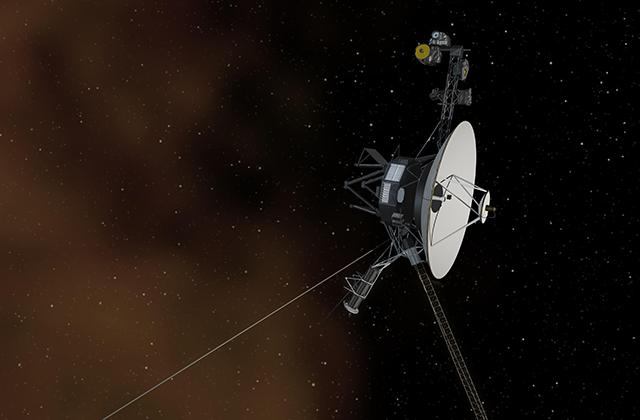Voyager spacecraft detect new type of solar electron burst

The Voyager spacecraft continue to make discoveries even as they travel through interstellar space. In a new study, University of Iowa physicists report on the Voyagers' detection of cosmic ray electrons associated with eruptions from the sun--more than 14 billion miles away.
Credit: NASA/JPL
Physicists report accelerated electrons linked with cosmic rays.
More than 40 years since they launched, the Voyager spacecraft are still making discoveries.
In a new study, a team of physicists led by the University of Iowa report the first detection of bursts of cosmic ray electrons accelerated by shock waves originating from major eruptions on the sun. The detection, made by instruments onboard both the Voyager 1 and Voyager 2 spacecraft, occurred as the Voyagers continue their journey outward through interstellar space, thus making them the first craft to record this unique physics in the realm between stars.
These newly detected electron bursts are like an advanced guard accelerated along magnetic field lines in the interstellar medium; the electrons travel at nearly the speed of light, some 670 times faster than the shock waves that initially propelled them. The bursts were followed by plasma wave oscillations caused by lower-energy electrons arriving at the Voyagers’ instruments days later–and finally, in some cases, the shock wave itself as long as a month after that.
The shock waves emanated from coronal mass ejections, expulsions of hot gas and energy that move outward from the sun at about one million miles per hour. Even at those speeds, it takes more than a year for the shock waves to reach the Voyager spacecraft, which have traveled further from the sun (more than 14 billion miles and counting) than any human-made object.
“What we see here specifically is a certain mechanism whereby when the shock wave first contacts the interstellar magnetic field lines passing through the spacecraft, it reflects and accelerates some of the cosmic ray electrons,” says Don Gurnett, professor emeritus in physics and astronomy at Iowa and the study’s corresponding author. “We have identified through the cosmic ray instruments these are electrons that were reflected and accelerated by interstellar shocks propagating outward from energetic solar events at the sun. That is a new mechanism.”
The discovery could help physicists better understand the dynamics underpinning shock waves and cosmic radiation that come from flare stars (which can vary in brightness briefly due to violent activity on their surface) and exploding stars. The physics of such phenomena would be important to consider when sending astronauts on extended lunar or Martian excursions, for instance, during which they would be exposed to concentrations of cosmic rays far exceeding what we experience on Earth.
The physicists believe these electrons in the interstellar medium are reflected off of a strengthened magnetic field at the edge of the shock wave and subsequently accelerated by the motion of the shock wave. The reflected electrons then spiral along interstellar magnetic field lines, gaining speed as the distance between them and the shock increases.
In a 2014 paper in the journal Astrophysical Letters, physicists J.R. Jokipii and Jozsef Kota described theoretically how ions reflected from shock waves could be accelerated along interstellar magnetic field lines. The current study looks at bursts of electrons detected by the Voyager spacecraft that are thought to be accelerated by a similar process.
“The idea that shock waves accelerate particles is not new,” Gurnett says. “It all has to do with how it works, the mechanism. And the fact we detected it in a new realm, the interstellar medium, which is much different than in the solar wind where similar processes have been observed. No one has seen it with an interstellar shock wave, in a whole new pristine medium.”
###
The findings were published online in the Astronomical Journal, in a paper titled “A Foreshock Model for Interstellar Shocks of Solar Origin: Voyager 1 and 2 Observations.”
Co-authors include William Kurth from Iowa; Edward Stone and Alan Cummings from the California Institute of Technology; Bryant Heikkila, Nand Lal, and Leonard Burlaga from the NASA Goddard Space Flight Center; Stamatios Krimigis and Robert Decker from the Applied Physics Laboratory at Johns Hopkins University; and Norman Ness from the University of Delaware.
NASA funded the research.
All latest news from the category: Physics and Astronomy
This area deals with the fundamental laws and building blocks of nature and how they interact, the properties and the behavior of matter, and research into space and time and their structures.
innovations-report provides in-depth reports and articles on subjects such as astrophysics, laser technologies, nuclear, quantum, particle and solid-state physics, nanotechnologies, planetary research and findings (Mars, Venus) and developments related to the Hubble Telescope.
Newest articles

Innovative 3D printed scaffolds offer new hope for bone healing
Researchers at the Institute for Bioengineering of Catalonia have developed novel 3D printed PLA-CaP scaffolds that promote blood vessel formation, ensuring better healing and regeneration of bone tissue. Bone is…

The surprising role of gut infection in Alzheimer’s disease
ASU- and Banner Alzheimer’s Institute-led study implicates link between a common virus and the disease, which travels from the gut to the brain and may be a target for antiviral…

Molecular gardening: New enzymes discovered for protein modification pruning
How deubiquitinases USP53 and USP54 cleave long polyubiquitin chains and how the former is linked to liver disease in children. Deubiquitinases (DUBs) are enzymes used by cells to trim protein…


